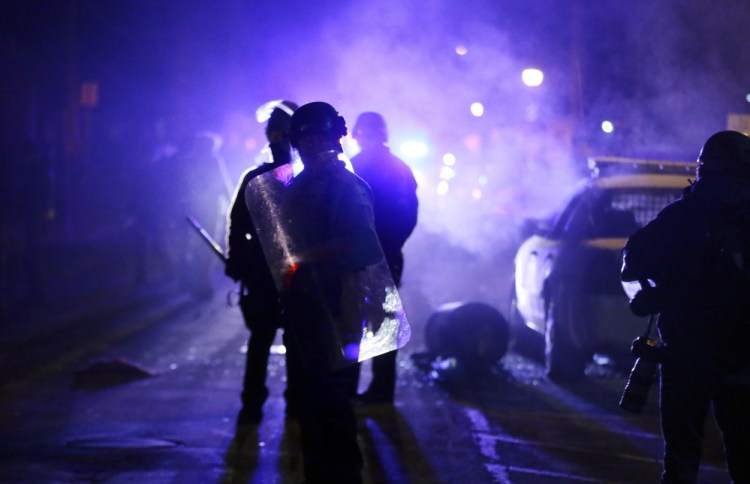WASHINGTON— With tensions high over police shootings, an influential Washington police think tank recently proposed a new approach: retraining officers to avoid conflict whenever possible and stressing the “sanctity of life” of everyone involved, not just the officers’.
While many departments were quick to embrace “de-escalation” training, there also has been a sustained pushback by police unions, street officers and police chiefs who say the approach could cause dangerous hesitation at times when officers need to be decisive.
“What a ridiculous piece of claptrap!” wrote the vice president of the Association for Los Angeles Deputy Sheriffs in response to a suggestion that before using force, officers consider how the public might view their actions. The officers union in San Antonio is holding a vote of no confidence on the police chief there. And in an extraordinary partnership, the Fraternal Order of Police and the International Association of Chiefs of Police issued a joint statement denouncing the proposals from the Police Executive Research Forum (PERF), saying that “we must continue to place our trust in the law enforcement practitioners who protect our streets and neighborhoods,” not some District of Columbia think tank.
“PERF and Their Questionable Principles” was the headline of a critical analysis on Officer.com. “PERF’s Use of Force report illustrates disconnect between street cops, administrators,” read a headline on PoliceOne.com.
The backlash shocked a number of big-city police chiefs and PERF executive director Chuck Wexler, who authored the “30 Guiding Principles” for police use of force, subtitled “Taking Policing to a Higher Standard.” Milwaukee Police Chief Edward Flynn, formerly the chief in Arlington County, Virginia, fired off an email to the IACP saying he was “appalled by the stridency, hyperbole and vituperation dripping from your joint communication” with the FOP “at this time when our profession is under scrutiny on exactly this topic.”
The clash at the top echelons of U.S. policing could determine whether law enforcement makes a nationwide change in how it uses lethal force on civilians, particularly in cases where a person does not have a gun. Police killed 990 people in the United States in 2015, according to a Washington Post database, of which 9 percent were unarmed, 16 percent wielded knives and 5 percent used their vehicles as weapons.
“I don’t think policing has faced this kind of fundamental challenge in over 20 years,” Wexler said. “This is, for better or worse, a nationwide conversation that police departments are having. And it is hitting people like a Rorschach test, all different ways. We’re talking about ways to prevent officers from getting into those split-second decisions, and people are reading into it what they want.”
Sean Van Leeuwen, vice president of the Association for Los Angeles Deputy Sheriffs, said, “Nobody would argue with the premise that reducing shootings by law enforcement is a worthy goal.” But, he said, “to impose a set of rules that don’t apply to the suspect places us at a disadvantage.”
Van Leeuwen cited the fatal shooting of Sgt. Jason Goodding in Oregon in February by a man who refused to show his hands, was shocked with a Taser, then pulled a concealed gun and fired. “Clearly the criminal suspects are not following PERF’s principles,” Van Leeuwen said.
The key word for police in use-of-force situations is “reasonableness”: Were an officer’s actions “objectively reasonable” as the situation appeared to him at that moment, according to the 1989 U.S. Supreme Court decision in Graham v. Connor.
Police policy has gradually changed in some areas over the years, other chiefs noted. Where high-speed chases were once normal, they are now rare because of the dangers they pose, said Michael Chitwood, police chief in Daytona Beach, Fla., and former Portland, Maine, police chief.
“I don’t understand what the uproar is,” Chitwood said. All officers in his department underwent de-escalation training to keep themselves and those with whom they interact from getting hurt, he said. Wexler’s proposal that a supervisor be summoned to every tense scene has been shown to reduce violence, Chitwood said, as have the proposals to increase crisis intervention training for dealing with the mentally ill, prohibiting the use of force on people who are a danger only to themselves, and administering immediate aid to someone who has been shot.
Send questions/comments to the editors.



Success. Please wait for the page to reload. If the page does not reload within 5 seconds, please refresh the page.
Enter your email and password to access comments.
Hi, to comment on stories you must . This profile is in addition to your subscription and website login.
Already have a commenting profile? .
Invalid username/password.
Please check your email to confirm and complete your registration.
Only subscribers are eligible to post comments. Please subscribe or login first for digital access. Here’s why.
Use the form below to reset your password. When you've submitted your account email, we will send an email with a reset code.